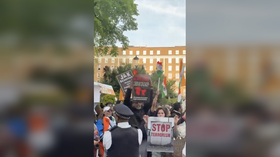‘Neither dead nor alive’: Former Gitmo inmate recalls horrors of infamous camp & CIA black sites
Being detained in the Guantánamo Bay camp was like hovering between life and death but the CIA-run ‘black sites’ were even worse, a man who spent 15 years –without charge– in the infamous facility has told RT’s Going Underground.
Mansoor Adayfi, from Yemen, who was confined in the US’s most notorious detention camp between 2002 and 2016, is still tormented by the traumatic experience he had there. Detained because of alleged ties he had to Al-Qaeda, he was eventually released without charge.
“We were totally disconnected from the world outside. I was really afraid and confused. Did not know what was going to happen to me. We felt like [the Americans] were going to kill us,” he told the show’s host Afshin Rattansi, adding that living there was “like hell, really.”
The interrogators applied “some torture techniques to interrogate detainees” and openly threatened the inmates with death, claiming also that the world would not even know about their demise.
They said they were going to kill us and throw us into the sea. They said the world does not know about you [being brought] here
Some detainees could not stand physical and mental torture and eventually succumbed to insanity, he claims. “I watched some detainees lose their minds, break down,” the Yemeni, who was just 19-years-old when he was placed into Gitmo, recalled.
“Everything around is designed to break you, to make you suffer. The treatment, the rules, the food, the cleaning, the clothes, everything.”
Also on rt.com CIA Director Gina Haspel may have run ‘black site’ at Guantánamo Bay, court docs revealArt was what helped him and some other inmates live through the nightmares of their years-long detention, Adayfi said: “Painting would give one a feeling for some moments that you are not in jail.” First, the inmates started to use improvised materials like toilet paper or Styrofoam cups for drawing. However, the guards “would punish us if they found anything.”
“It was not until 2010 where we had a class. After a hunger strike, after [US President Barack] Obama came to office, they made some changes in Guantánamo. We asked for art. And it helped us survive,” the man said.
Adayfi was one of those inmates whose works were then exhibited in New York as part of an ‘Ode to the Sea: Art from Guantánamo Bay’ show, which received widespread coverage in the western media.
‘No limitation to what they can do to us’
Despite all his ordeals in Guantánamo, Adayfi says it was, in fact, not the worst place he had been sent to during his detention period, as the so-called ‘black sites’ run by the CIA in some third countries – like a secret prison in Thailand codenamed ‘Cat’s Eye,’ which was once managed by the current CIA chief, Gina Haspel – were even worse.
“I was in the CIA black sites, it was worst ever, even when I talk about it, it breaks me. There was no limitation to what they can do to us, no limitation, whatever they want, some detainees died under torture,” the Yemeni said.
You just become a ghost, you spend two, three, four, five months, one year just blindfolded, loud music, naked, hanged to the ceiling or tied to a wall. Sometimes we could not walk, we would collapse, they would drag us along the ground
‘Mentally, I can’t escape’
Adayfi’s suffering did not just end with his release. After spending 15 years in detention without charge, he was eventually cleared by the Periodic Review Board and sent to Serbia, a country where he had no friends, relatives or even acquaintances. While his homeland, Yemen, was already engulfed in a bloody conflict at that time it is not exactly clear what prompted that decision.
At the time, the then-US Secretary of State John Kerry thanked Belgrade for “the generous assistance of Serbia as the United States continues its efforts to close the Guantánamo Bay detention facility.” Two years on and more than 17 years since it was created, Guantánamo camp continues to operate.
Also on rt.com ‘This is not the Obama admin’: Bolton unveils Trump’s new far-reaching counter-terrorism strategyThe Trump administration’s strategy states that Guantánamo will remain open and operational, and calls to “maximize the utility” of it.
As for Adayfi, he says he’s been left to face the horrors of his past all alone.
“I am still in Guantánamo. I am still there mentally because I live in a society where I have no friends, no family, no program that helps me with rehabilitation and reintegration, vocational training basics,” he explained.
I am stuck in Guantánamo, mentally I can’t escape, I feel the same thing, I behave the same way. I react the same way because for me it is still very hard and difficult, I have not moved yet
What concerns him even more, however, is the news from Yemen, where his relatives and friends remain, and where the US is allegedly helping to establish more ‘black sites’ amid the Saudi-backed war on Houthi rebels.
The areas effectively controlled by the Emiratis and the Saudis are used to build “a new Abu Ghraib jail,” Adayfi claims, referring to another notorious prison run by the US military and CIA operatives in Iraq. Some of the facilities are staffed with US interrogators, the Yemeni claimed. “They supervise everything the Emiratis and the Saudis [do], they supervise the interrogations there,” he added.
Think your friends would be interested? Share this story!












